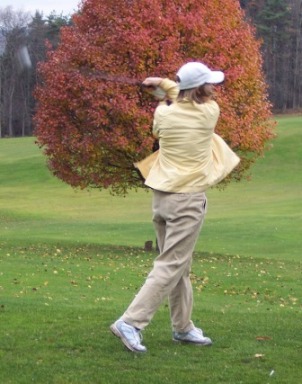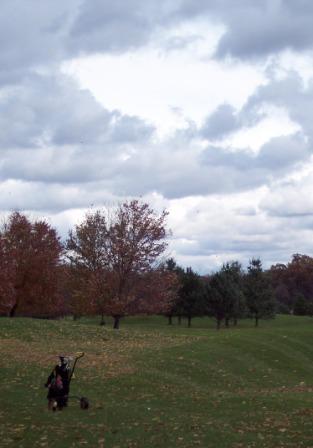I’ve been thinking more about Tim Gallwey’s book, The Inner Game of Golf, and the implications of what he discovered about executing the golf swing.
Gallwey observed that there are two different “modes” of being that affect a golf swing. One is judgmental, critical, verbal, analytical. The other is kinesthetic and sub- or non-verbal.
It’s always tricky to describe different aspects of the self or psyche or personality. Gallwey was no dummy. He was writing in the 70s for an audience that hadn’t been acclimated to new agey-type material. So it’s no coincidence, I’m sure, that the terminology he coined to describe these two modes was pretty dry: Self 1 and Self 2, respectively.
As simple designations within the context of mastering a golf (or tennis) swing, that terminology works. But what about off the course?
“Self 2” is a mode of being that is gained by intent, trust, and a shift to pure awareness — the same state we try to achieve during certain types of meditation. It’s the mode that we associate with “being in the zone,” where everything just flows effortlessly. There’s a kind of magic to it. Here’s a bit from the book:
Before I address the ball, I look at the situation and let Self 2 pick the target. I see the ball already there and convince Self 1 that the results are already accomplished. You might say that I pretend that the desired results have already occurred. This leaves Self 1 with nothing to be tense about or to doubt. It is the ultimate in the doctrine of the easy — what could be easier than to do something that has already taken place?
Now all that is left is to enjoy hitting the ball. In effect, I say to myself, Now that the ball has already landed where you want it, how would you like to have hit it there? Then I express the quality I want to experience by hitting the ball the way I really want to, allowing Self 2 to express himself to his full limits.
Within the scope of Gallwey’s work, this phenomenon resolves down to body vs. “head.” The body knows how to swing a golf club. The golfer must simply get his head out of the way so that his body can execute the swing unimpeded.
But anyone who’s looked at any of the “self help” literature published in the 40 years since Gallwey’s first Inner Game books will recognize this template. What’s more, it’s been applied — over & over — to activities that have nothing to do with sports. From Joseph Murphy and Neville Goddard up through Esther Hicks and Deepak Chopra, the advice is identical to Gallwey’s golf swing routine: set a goal, picture it accomplished, and then get out of the way and let the path to the goal unfurl.
What’s interesting is the terminology people use to describe “Self 2.” Murphy is one of many who use “subconscious.” Neville Goddard — perhaps reflecting how slippery this terminology becomes — sometimes fell back on metaphor but also used “Imagination,” “The Divine Body,” “the inner body” (in e.g. Awakened Imagination), “consciousness,” and the “I AM” (e.g. The Power of Awareness). Some writers go right to the heady mystery of it and ascribe to it Divinity (“let go and let God”). Others don’t bother with naming it at all, but focus on process.
Mulling all this over the past few days, the term I’m drawn to most, unfortunately, is “daemon.” Unfortunately because a daemon, to inheritors of the Judeo-Christian tradition, is a demon, aka evil disembodied creature best left well alone. Too bad we can’t rescue the word, at least in some form — revert back to how Socrates, for instance, spoke of his daimonion (“little daimon”) in terms of
“a divine or supernatural experience . . . It began in my early childhood — a sort of voice that comes to me; and when it comes it always dissuades me from what I am proposing to do, and never urges me on.”
That’s from Plato’s Apology, my Penguin Classics edition I picked up somewhere for two bucks.
Socrates was drawing on an older use of the word, as described here by Wikipedia:
The Proto-Indo-European root *deiwos for god, originally an adjective meaning “celestial” or “bright, shining” has retained this meaning in many related Indo-European languages and cultures (Sanskrit deva, Latin deus, German Tiw, Welsh [Duw],]), but also provided another other common word for demon in Avestan daeva.
In modern Greek, the word daimon (Greek: ??????) has the same meaning as the modern English demon. But in Ancient Greek, ?????? meant “spirit” or “higher self”, much like the Latin genius. This should not, however, be confused with the word genie, which is a false friend or false cognate of genius.
Socrates’ daimonion got him in a world of sh*t, of course, since the Athenians in power were nervous about people following their own little daimons instead of state-recognized gods.
Politics aside, to my thinking, the Socratic notion of daimon gets a little closer to the real nature of Self 2. Self 2 is more than mere body consciousness; it possesses an intelligence that is in many ways superior to that of Self 1, and capabilities that extend beyond mere physical acts. This explains why it comes into play in experiences that involve more than our bodies — that involve events and objects over which we have no direct physical influence. It explains as well its association with our blessings and success — one’s daimon serves as a midwife who delivers blessings into one’s life.
That said, I’m equally impatient with teachings (including a lot of Buddhist literature) that denigrate Self 1. Just because we develop habits of self-criticism that are against our best interests doesn’t mean Self 1 is an obstacle to be overcome or destroyed (!) — we are as wrong to demonize the ego as to demonize the daimon. Both were given to us by the source God, after all. Instead, we should view Self 1 as a kind of personal GPS: it feeds back data we need about where we are and whether our coordinates are to our liking, and identifies conditions that we can use for goal-setting.
The trick is to cultivate a partnership between these two “selves.” Ideally, Self 1 evaluates current coordinates and pinpoints suitable future coordinates. Then Self 2 — the daimon — guides us and executes the actions necessary to move us toward those coordinates.
That’s where the giddiness comes in, of course, because much of what the daimon does is invisible to the ego. So Self 1 has to chill out and trust that its goals will be met even though evidence of that fact might be in scarce supply. Faith as evidence of things unseen and all that.
What Gallwey discovered is that during this stage, we can fall back on simple awareness. This displaces our tendency to over-analyze or engage in constant verbal critiquing — mental activities that inhibit the daimon’s ability to do its work.
None of this gibes with official Christianity, of course, a discrepancy that Philip Pullman has tried to exploit with the His Dark Materials books. Too bad, really — Pullman is no doubt very bright, but a spiritual crank (c.f. his fixation with mischaracterizing the writings of a man who, being dead, can’t defend them. What a waste of fame.) Even without intellects like Pullman’s around to egg things on, however, I suppose it would take some time before we could return “demon/daemon/daimon” to its rightful usage — in fact, if I were a scholar I’d look for evidence that early Christian authorities took their position on demons right from the Athenian playbook. Persuade people to mistrust their inner voice and you make them dependent on your official pronunciations. It’s an old trick but we still fall for it, sorry, Socrates.
Or we keep our work beneath the radar by using terms like “subconscious” or “Self 2” — words that are safe precisely because they don’t evoke the real mystery and power that is there for us to explore — if we dare to trust how close we really are to the divine . . .




